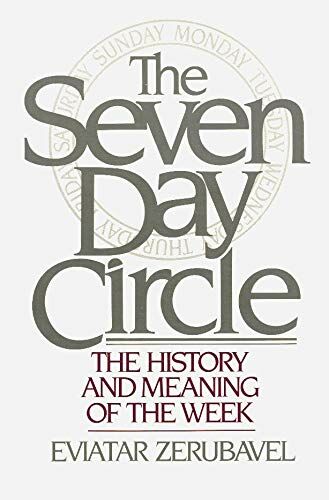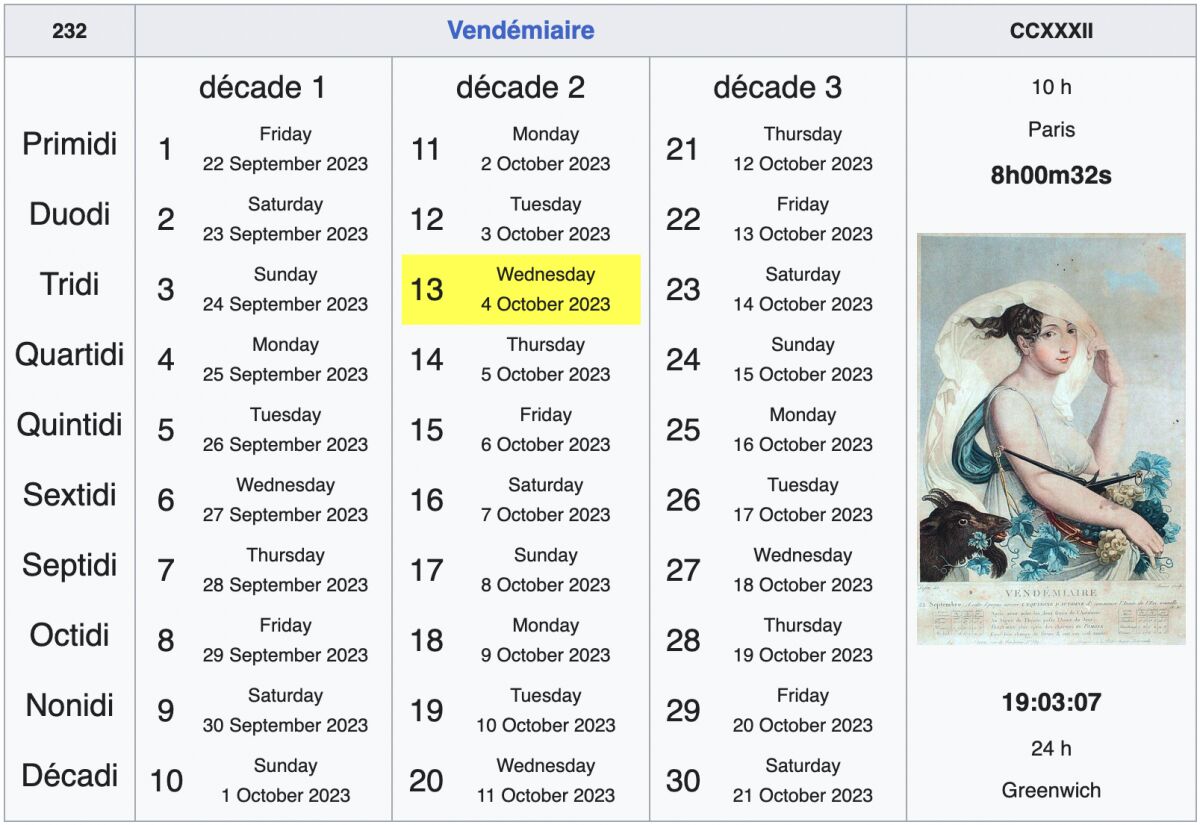Why the Week?
Why is it that the Wednesday just before Thanksgiving feels so much like a Friday? Why are most tv shows aired every seven days instead of every four or five? And why is it easy enough to mistake a Tuesday for a Wednesday, but almost impossible to mistake a Friday for a Saturday?
These questions point to something so pervasive, so universal, and so deeply entrenched in our lives that we often take it for granted: the seven-day week. Next to the day, the week is the most important calendar unit in our lives.
How did this seven-day cycle come to so conspicuously occupy our minds and our calendars? Where did it originate? How did it become such a ubiquitous backbeat in the rhythm of human life?
Most other major measurements of time are determined by what happens in the skies above us. The length of a year is determined by how long it takes our planet to make one full revolution around the sun. The month is based on the time required for our moon to complete its cycle. A day is the time the Earth takes to complete one full rotation on its axis.
But what about the week? What astronomical cycle determines this seven-day span?
Divided Lunar Cycle Theory
One common explanation says the week is based on one quarter of the 29.531-day lunar cycle, which would come to nearly 7.4 days. Proponents of this theory say ancient peoples used the moon’s cycle to determine the duration of both the month, in its complete cycle, and the week, as one quarter of that cycle. They say this quartered lunar cycle gave rise to a calendar, like those used by early Babylonians, in which each month began on a new moon and was separated into four 7-day segments followed by one or two odd days each month.
In The Origins of the Seven-Day Week, Eviatar Zerubavel dismisses this theory. “One of the most distinctive features of the week is the fact that it is entirely dissociated from the lunar cycle,” he writes. “It is essentially defined as a precise multiple of the day, quite independently of the lunar month. … Any subdivision of the lunar cycle necessarily involves some mathematically inconvenient remainder of hours, minutes and seconds. A precise quarter of the lunar cycle, for example, amounts to 7.38625 days, and any week of that length would necessarily have to begin at different times of the day.”

The divided lunar cycle theory also does not explain the fact that, in almost all societies, the week is seven days long. After all, a lunar month could just as easily be divided into three 10-day sections, or five 6-day blocks, six 5-day spans, or other variations, with the final “week” being shortened by a day or two as needed. Why would early societies choose to divide the lunar cycle by four? The number is arbitrary. Other major units of time—the day, month and year—are derived from complete astronomical cycles, which are clearly visible in the skies. But the divided lunar cycle explanation for the week is built on an arbitrary, man-made division.
Visible Celestial Bodies Theory
Another popular explanation for the week comes from adding up the number of celestial bodies in our solar system that are visible with the naked eye. The sun, the moon, Mercury, Venus, Mars, Jupiter and Saturn would all have been visible to early stargazers who had no telescopes, so the sum is seven.
Peter Meyer of Hermetic Systems explains this theory: “[I]t is obvious why there are seven days in a week: This is the number of visible planets plus the sun and the moon. If, instead of an asteroid belt between Mars and Jupiter, there had been a planet, then there would have been six visible planets, not five, so the number of celestial entities would have been eight, not seven. In that case humans would have developed a week of eight days, not seven.”
It is undeniable that the days of the week on our calendars (in English and European languages) are named after the visible bodies (e.g. “the day of Saturn” is Saturday). It’s also true that ancient societies named these celestial bodies after their various gods and goddesses. However, the facts of history prove that the seven-day week existed long before its days came to be associated with these ancient gods, and that the association came about only in the third century b.c.e.

Originally, the seven visible bodies were used only for ancient Babylonian fortune-telling and had no influence on the week or any other cycle of human life. Zerubavel explains this by saying, “[W]hile the Chaldean origin of astrology is indisputable, there is no evidence that an actual astrological seven-day cycle ever existed in ancient Mesopotamia …. A permanent correspondence between the Sabbath and ‘the day of Saturn’ was thus established no later than the first century of the present era …. Sabbath observance had been established long before the astrological week ever came into being, and obviously preceded both the making of the calendrical association between ‘the day of Saturn’ and the Sabbath and the naming of the planet after the latter.”
So, the association between celestial bodies, pagan gods and the seven days of the week didn’t happen until many centuries after widespread adherence to the week. Thus the visible celestial bodies theory doesn’t explain the week’s origins any better than the divided lunar theory. History and logic easily disprove both of these theories, and reveal how weak they really are.
An Invention of Ancient Israel?

In his thorough book, Zerubavel, after conclusively disproving both of the above theories, finally concludes that the seven-day week was the invention of ancient Israel. He says that it eventually spread from that early society into the whole world.
The trouble with that theory, though, is that biology proves the seven-day week predates all societies.
Mankind has long understood that our bodies operate on circadian (daily), monthly and annual rhythms, but chronobiologists have only recently discovered seven-day patterns written into the biology of people, animals and plants.
According to The Secrets Our Body Clocks Reveal by Susan Perry and Jim Dawson, the blood pressure cycle, coping hormone cycles, immune responses to infections, production of blood and urine chemicals, and even the heartbeat operate on a seven-day pattern.
Experiments conducted by scientist Franz Halberg also prove that seven-day cycles govern fundamental aspects in the lives of flies, rats and other critters. Research by Halberg, Perry, Dawson and others has uncovered no cycles (between daily and monthly frequency) that occur in five, six, eight, nine or any other number of days—only seven.
A rat can’t tell the Talmud from the Huffington Post, so, if the seven-day week was invented by people, as historians like Zerubavel maintain, what explains these biological seven-day rhythms?
The Week’s True Origins
The week is completely oblivious to seasons, tides, orbits and every other aspect of external nature. Nothing in the cosmos happens in seven days, so there is no astronomical reason for the week. There is no recurring cycle of the stars, moon, planets, sun, or anything else that happens in seven days’ time. So the week had to originate from another source. Science shows that the seven-day cycle is also etched deeply into mankind’s dna, proving it could not have been the invention of any society.
Many researchers have strained to attribute the week’s origins to something secular, but it cannot be done.
The Bible, however, provides a very different answer: that the week was created by God.
The first two chapters of the book of Genesis detail God’s creation (or re-creation) of the face of the Earth, with the Creator resting “on the seventh day” following the six days of creation. God further commanded rest on each seventh day, as an eternal tribute to God’s re-creation and rest (Genesis 2:2-3; Exodus 20:8-11; 31:15-17; Isaiah 56:2; also note New Testament passages such as Hebrews 4:1-11, etc). So, almost as a by-product of the work accomplished during these seven days, God also created the week.
Other calendar units are determined by heavenly bodies, but as the Bible reveals, the week was determined by the Creator.
The Sabbath Was Made for Mankind
“And God blessed the seventh day, and hallowed it” (Genesis 2:3). “Happy is the man that doeth this, And the son of man that holdeth fast by it: That keepeth the sabbath …” (Isaiah 56:2).
Leviticus 23:3 says, “[S]ix days shall work be done: but the seventh day is the Sabbath of rest, an holy convocation; you shall do no work therein …” (King James Version). Thus, the Bible relates that it was not just the Sabbath, but the entire seven-day week that was actually made for mankind. The command to labor for six days is every bit as clear as the command to rest on the seventh.
Even in purely physical terms, there are some fascinating proofs that the seven-day rhythm of life leads to maximum productivity and health.
The seven-day week is ubiquitous around the world. In almost every nation and civilization on the planet, throughout all chapters of human history, you will find people living out their lives to the rhythm of the week. On one extreme, however, there are some few cultures that have operated on a week of only three or four days. At the time the 11th edition of the Encyclopedia Britannica was written, there were some isolated pockets in the Democratic Republic of the Congo where the people operated in “weeks” of only three or four days. In African Cultural Astronomy, author Jarita C. Holbrook discusses the Igbo people of Nigeria, pointing out that they function on a four-day week. And the same is true for some other isolated cultures around the world, although globalization and the technology explosion make such instances rarer all the time.
Rather than working six days and resting one, a person operating on a three-day week would work two days and then rest one. But the cultural and economic output of such cultures is naturally weaker than those of societies that labor six days before resting one.

On the other extreme are civilizations that have experimented with “weeks” longer than seven days. In 1793, just after the French Revolution, France adopted a 10-day week (along with a 10-hour day, 100-minute hour, and 100-second minute). The revolutionaries made the move in an effort to simultaneously de-Christianize the country and increase its productivity. But productivity did not increase. According to R. R. Palmer’s The World of the French Revolution, France only kept the 10-day week around for 12 years because of its extremely disappointing results. During these years, French society saw a stark increase in injuries, exhaustion, illness, and work animals that collapsed and died at astounding rates. These people were attempting to operate on a rhythm unnatural to the design of their bodies, and the results were disastrous.
Other societies have conducted similar week-extension experiments, but, like the French, they all reverted back to the seven-day model within a short time. As the Bible informs, the week and Sabbath was made for man, and mankind functions at its best when operating on a seven-day cycle. A shorter week reduces productivity to a trickle; a longer one places an unsustainable strain on workers. Not only is the command to rest on the seventh day, but also to work on the first six days. More or less than this, and penalties are inevitable.
The next time you stare into the night sky, you might look to the moon and consider how man has patterned the month after its cycle. Or you may consider the rotation or revolution of the Earth and how that has given us the day and year. But don’t waste time searching the firmament for something that explains the seven-day week.
For more about the biblical symbolism of the seven-day week, as it pertains to man’s history—and future—see our article, “The Hebrew Year 5784—Or Is It?”